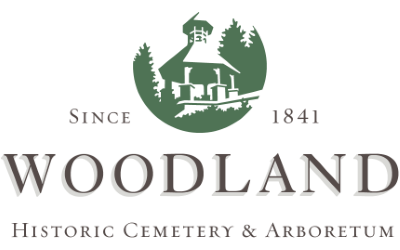After passing through the main gates of Woodland Cemetery, you will come to a fork in the road. Located on the north side of the Main Drive, you will see what is known as the Woodland Receiving Vault, one of the Cemetery’s oldest structures.
The Receiving Vault was constructed in 1847 by Joseph Wuichet, who was Dayton’s “premier” Stonemason during that time. It is constructed of giant limestone slabs and was designed as an exact replica of the Egyptian style temple of “Thebes and Karnak.” Mr. Wuichet agreed to receive payment for his services in grave spaces, which sold for $20.00 each at that time. The total bill for the construction of the Receiving Vault was $471.63.
The purpose of the Receiving Vault was to temporarily and securely house the remains of those who could not be immediately buried. The capacity at that time was 16 caskets (caskets being much smaller at that time). The main reason for storage in the vault was due to cold or severe weather. Graves were dug by hand in the 1800’s, it took 2 men working 8 hours to dig each grave. When the ground was frozen, burials had to be delayed therefore the Woodland Vault was used. The original cost to be placed in the vault was $1.00, an additional rental fee was charged if the remains were to be secured for a more substantial length of time.
The longest resident of the Receiving Vault was Matilda Stanley, The Queen of the Romani. She died in 1878, her body remained in the vault for nine months, awaiting the arrival of all the Romani clans to attend her service. Her family entered the vault daily placing flower petals on her casket until the day she was buried. It was estimated at the time that 25,000 romani attended her burial service.
The Woodland Receiving Vault exterior was recently restored to its original appearance and the area was landscaped.


